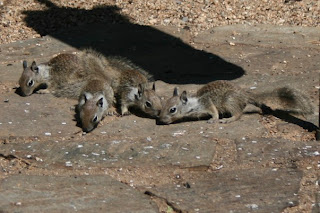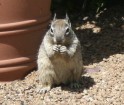 |
| Garden Shed |
Four years ago Cindy's engineer dad, Lou, helped us build a garden shed for Cindy's growing accumulation of garden tools.
We decided to build it out of polycarbonate panels attached to a wooden frame, using aluminum corner edging along the sides and top to make it reasonably weather tight. The translucent polycarbonate roof and sides allow light into the interior of the shed.
Since the shed was located on the north side of the house along a slope, we really appreciated Lou's engineering and woodworking skills in making the shed sit level on the slope. He also suggested using a closet door railing to hang the two big sliding doors from so that they slide open easily.
Over the last four years, the shed has held up very well and still looks very good. However, one thing we had talked about but not done was to secure some aluminum tracks along the floor of the shed so that the doors would slide easily but stay in place. It was just one of those things on the "to do" list that never got done.

So while we were gone, San Diego had a huge windstorm that blew the doors right off the shed. Fortunately, they didn't blow very far away and a friend was able to retrieve them and put them in the garage until we got back.
That made it essential to fix the problem. At first we contemplated making wooden frames for the doors to correct their tendency to bow, which made it easier for them to blow off the track. Wooden frames would have been possible to construct, but would have made the doors much heavier and much more cumbersome to use.
Engineer Lou came to our rescue once more and suggested we use aluminum channel instead of wood. We chose an asymmetric 1/4 inch U-channel, with one side 1/4 inch high and the other 3/4 inch. We ran a bead of silicone caulk along the long side before we attached them to the doors.
It was easy to cut the aluminum and we were both amazed at how the doors instantly stiffened and ceased to bow. Then it was a matter of re-hanging them, running a bead of silicone on the shed floor to secure the 1/2 inch U-channel for the bottom track and letting the silicone cure.
The only thing left to do to the project is to find some way to secure the doors. Because there is a gap of a couple of inches between the edge of the shed and the door, that part is going to be a challenge.
Lou? Got any more brilliant ideas?














